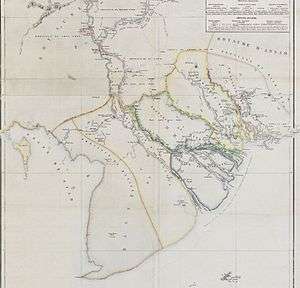Siamese–Vietnamese War (1841–1845)
| Siamese-Vietnamese war (1841–45) | |||||||
|---|---|---|---|---|---|---|---|
| Part of Siamese–Vietnamese Wars | |||||||
 A map showing the movement of Vietnamese troops (from June to December 1845) in Vietnam-Siamese War (1841–1845). | |||||||
| |||||||
| Belligerents | |||||||
|
|
| ||||||
| Commanders and leaders | |||||||
|
|
| ||||||
| Units involved | |||||||
|
|
| ||||||
The 1841–1845 Siamese-Vietnamese War in Cambodia was a war between Vietnam (then under the rule of the Nguyen Dynasty) and Siam (Thailand) under the House of Chakkri. In the increasingly confrontational rivalry between Vietnam and Siam, the conflict was triggered by Vietnam's absorption of Cambodia and the demotion of the Khmer monarchs. Siam seized the opportunity to intervene as the tide of Khmer discontent rose against Vietnamese rule.
Historical context
After Vietnam defeated Siam in the 1831–1834 war, the Vietnamese-installed Queen Ang Mey held on to the Cambodian throne during a period of increased Vietnamese influence over the country. Vietnamese occupation and oppression triggered a rebellion in 1841 with Cambodians overthrowing the pro-Vietnamese faction. The rebels appealed to Siam who supported another claimant to the Cambodian throne, Prince Ang Duong. Rama III responded and sent Ang Duong back from exile in Bangkok with Siamese troops to install him on the throne.
Military campaigns
Facing increasing instability, the Vietnamese forces abandoned Cambodia and retreated to An Giang. Seizing the opportunity, the Siamese launched an offensive in February 1843, Chao Phraya Bodindecha, was assigned the mission of the capture of Saigon, with Dis Bunnag the Minister of Kromma Tha commanded the fleet - to be joined at Saigon. The two Cambodian princes, Ang Im and Ang Duong, also joined the expedition. Bodindecha took Oudong and the fleet took Bantey Mas, then the Siamese army capturing Cô Tô mountain. However Vietnamese reinforcements from Huế and central Vietnam quickly moved into the Mekong delta, halting the Siamese advance. By May the Vietnamese counter-offensive repelled the Siamese, recapturing Cô Tô and taking a large number of prisoners of war.
Meanwhile, in Cambodia, the Siamese occupying forces repeated the same heavy-handed mistakes of the Vietnamese, squandering the Khmer's trust. The Cambodians then sought Vietnamese assistance to fend off the Siamese overlords. In July 1845, the Vietnamese crossed into Cambodia, advancing north toward Phnom Penh. Within two months, on September 13, the capital fell to Vietnamese troops. The Siamese commander Bodindecha and Ang Duong retreated to Oudong. The Vietnamese continued the pursuit and in October, Oudong was besieged.
Encircled, Bodindecha sued for peace, and in November 1846, representatives of Bangkok and Hue were signatories the peace treaty, bringing the war to an end. Cambodia was placed under joint Siamese-Vietnamese protection. In January 1847, Ang Duong sent emissaries to pay tribute to both Siam and Vietnam, recognizing its joint vassalage to both the Court of Bangkok and the Court of Hue. This lasted until the French established a protectorate in 1863.
References
- Economic Equality and Victory in War: An Empirical Investigation
- 1825–1849
- Trần Trọng Kim, Việt Nam sử lược, Nxb Tân Việt, Sài Gòn, 1964
- Sơn Nam, Lịch sử An Giang, NXB Tổng hợp An Giang, 1988.
- Sơn Nam, Lịch sử khẩn hoang Miền Nam. Nxb Văn nghệ TP. HCM, 1994.
- Phạm Văn Sơn, Việt sử tân biên, Quyển 4. Tủ sách Sử học Việt Nam, sài Gòn, 1961.
- Hoàng Văn Lân & Ngô Thị Chính, Lịch sử Việt Nam (1858– cuối XIX), Q. 3, Tập 2. Nxb Giáo dục, 1979.
- Phạm Việt Trung – Nguyễn Xuân Kỳ – Đỗ Văn Nhung, Lịch sử Campuchia. Nxb Đại học và Trung học chuyên nghiệp, 1981.
- Vu Duc Liem. Vietnam at the Khmer frontier: boundary politics, 1802-1847, Cross-Currents: East Asian History and Culture Review, Vol. 5, no. 2 (2016).